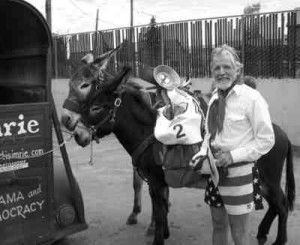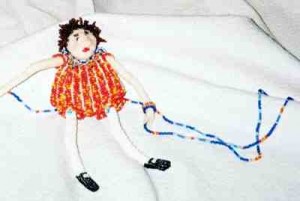Review by Ed Quillen
Wildlife – May 2008 – Colorado Central Magazine
Listening to Cougar – Edited by Marc Bekoff and Cara Blessley Lowe
Forward by Jane Goodall
Published in 2007 by University Press of Colorado
ISBN 978-0-87081-894-3
ON OCCASION when I read an anthology, I think “Why wasn’t I asked to contribute? I’ve written a piece or two that would fit in well here, or I could write one.” But in this case, I am glad that I am not qualified. By and large, these pieces are about sightings of cougars, and it suits me fine that I have never seen a mountain lion in the wild.
Indeed, I try not to look too long at suspicious tracks and scat when I’m out walking the dog in some nearby gulch. When such evidence says “A cougar was through here in the recent past,” it puts a pall on the day. I find myself glancing around anxiously, rather than enjoying the outing. I’ve never seen Cougar, but I’m pretty sure Cougar has seen me, and I don’t find it a pleasant sensation.
Felis concolor, with many subspecies, ranges throughout South America and across western North America, with a small population also in Florida. The big cat once ranged all across eastern North America. On account of its immense range, it may hold the world’s record for the species with the greatest number of vernacular names, among them cougar, mountain lion, panther, puma, catamount, and mountain screamer.
By any name, it’s an interesting beast with strong survival skills. In Colorado, we managed to extirpate wolves and grizzly bears, the two other big predators of yore. Despite the traps and professional hunters, the cougar held on, and is sometimes observed in downtown Boulder these days.
Is their range expanding or contracting? Are populations growing or shrinking? As Wendy Keefover-Ring points out in “A Short, Unnatural History,” we simply don’t know. The cats are elusive and usually shy around humans, and records are generally scanty.
Colorado has the best records of any state, and there’s a surprise in them. From 1881 to 1965, hunters could claim a $50 bounty by turning in a cougar scalp to the county clerk, along with an affidavit as to which county the cougar was shot in. After 1965, cougar-hunting was regulated like other wild game.
One would think that the bounty system (in popular psychology at the time, cougars were ravenous killers of virtuous fawns) would produce more cougar kills than sport hunting. But Keefover-Ring reports that, on average, 45 bounties were paid out each year. Under the sport-hunting regimen from 1997 to 2006, an average of 345 cougars were killed each year.
And what does this mean? “Truthfully, no one knows. Pumas, after all, are cryptic creatures. But their highly secretive nature, although a challenge to researchers, is likely what has saved them from extinction.”
The selections in this anthology cover just about every aspect of human-cougar interactions, ranging from direct encounters to dreams to fourteen pages of “The Sacred cat: The Role of the Mountain Lion in Navajo Mythology and Traditional Lifeway.”
The best reading — for me anyway — was the oldest piece in the book, “Lion Markers,” by J. Frank Dobie, originally published in 1928. It’s just the story of a New Mexico cougar hunt — a long and exhausting pursuit on foot and horseback in rough country — but Dobie is a great story-teller, whether you’re rooting for the hunters or the cougar.
Some of the other selections were a little too New-Age infuse-yourself-with-Cougar-spirit to suit me, even though they were eloquent. Given my own fearful feelings about these big cats, I had trouble sharing some writers’ excitement at actually seeing a cougar in the wild. But it led to some thought that I might feel differently if I had actually spotted one.
What to do if you encounter a lion? Perhaps there’s no need to think about it, because instincts seem to take over. Marc Bekoff, one of this book’s editors as well as a contributor, is a professor emeritus of ecology and evolutionary biology at the University of Colorado. He ran from the first lion he encountered.
When he told people about it later, “some had the audacity to tell me that it was stupid of me to run. They informed me that it’s best to tell the lion who’s boss by yelling and screaming and shaking your fist or some object — like a tree branch — at him. As a field biologist who has studied coyotes for years, I of course knew that it was best to intimidate a lion, not run from him or her. But I must say that when I looked the cougar in the eye from about two feet away, instinct took over. Fleeing trumped remaining and trying to convince him that I wasn’t scared. I was scared.”
Nonetheless, the editors provide “Cougar Country Safety Tips” in an appendix, with the important warning that “where there are deer [i.e., any town in Central Colorado], there could be cougar.”
Another appendix lists all verifiable human deaths by cougar attack from 1890 through 2004. They’re extremely rare: 18 in the last 100 years, which is as many people as died from dog bites in 2002 alone.
This answers a question that came to mind as I read this book. When we moved to Salida 30 years ago, dogs pretty much ran free. The city clamped down. Then we started seeing a lot of deer in town, presumably because loose dogs no longer chased them away. And with deer, there are mountain lions. So which is more dangerous — loose dogs or mountain lions? From these statistics, it’s better to control the dogs and take your chances with the deer and lions.
This book has a goal: to increase public knowledge of cougars, and thereby to influence game management and habitat protection. It succeeds pretty well at imparting knowledge, as well as lore. As for whether it will influence policy, we’ll have to see. So far, though, the cougar seems to have figured out how to survive despite our best efforts.


